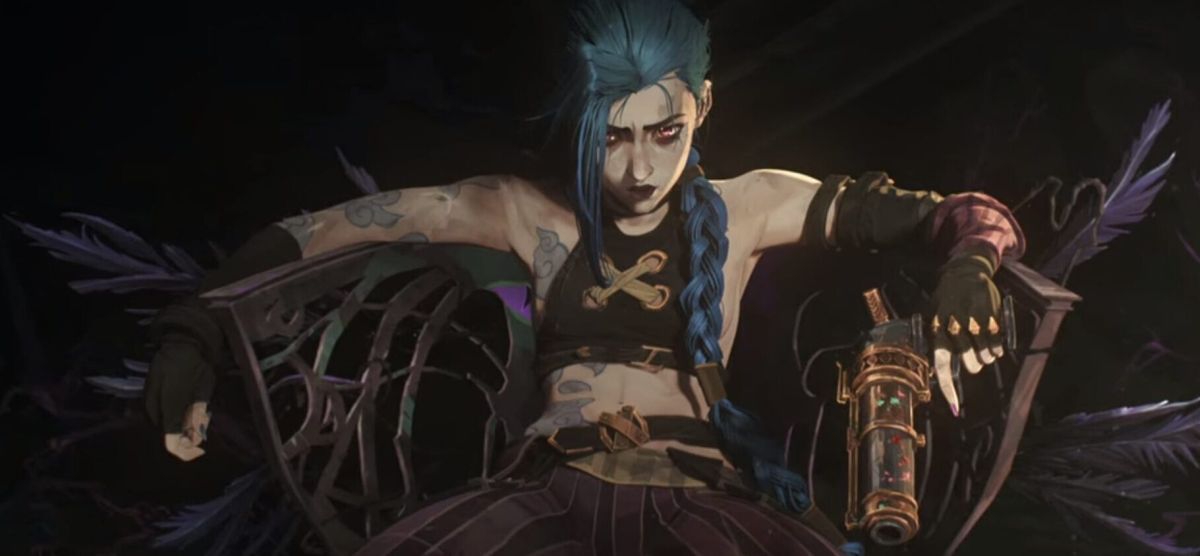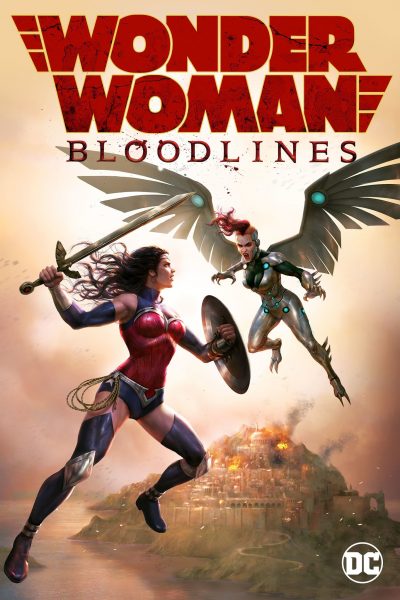★★★½
“A tale of two sisters.”
 I’ve never played League of Legends, but the good news is, you don’t need to, in order to enjoy Arcane. While that may provide some extra depth, it works perfectly well on its own. There is a degree of over-familiarity with the high-level scenario, which is Generic Fantasy Plot #3. Per Wikipedia’s premise, “Amidst the escalating unrest between the advanced, utopian city of Piltover and the squalid, repressed undercity of Zaun…” Yeah, it’s class war time again, cut from the same basic stamp as Mortal Engines, Alita: Battle Angel and The Hunger Games. To this series’s credit, it does show more nuance than some, with good and bad on both sides of the divide. Perhaps a bit too much though, as there were points where it felt like new characters were being thrown at the viewer, even late into the nine-episode series, when the time might have been better spent developing existing ones.
I’ve never played League of Legends, but the good news is, you don’t need to, in order to enjoy Arcane. While that may provide some extra depth, it works perfectly well on its own. There is a degree of over-familiarity with the high-level scenario, which is Generic Fantasy Plot #3. Per Wikipedia’s premise, “Amidst the escalating unrest between the advanced, utopian city of Piltover and the squalid, repressed undercity of Zaun…” Yeah, it’s class war time again, cut from the same basic stamp as Mortal Engines, Alita: Battle Angel and The Hunger Games. To this series’s credit, it does show more nuance than some, with good and bad on both sides of the divide. Perhaps a bit too much though, as there were points where it felt like new characters were being thrown at the viewer, even late into the nine-episode series, when the time might have been better spent developing existing ones.
The central pair are sisters Vi (Steinfeld) and Powder (Purnell), orphaned after a failed rebellion. They’re brought up by the leader of the rebellion, and subsequently get entangled in the web of crime, politics, magic and science which powers both sides of the divide. There’s a lot going on here: simply summarizing it would fill the rest of the article. But there are a couple of key points. Powder becomes estranged from her sister, changes her name to Jinx, and goes to work for crime lord Silco (Spisak). Scientist Jayce Talis (Alejandro) creates a technology called Hextech: this (Generic Fantasy Plot #7…) allows for the control of magical energy, which can used for good or evil. It also does… well, whatever the plot needs, from curing illness to blowing things up. Intrigue ensues. A great deal of intrigue.
I did appreciate the script’s complexity, which stands in contrast to most video-game adaptations. I think the greater length (9 x 40-ish minutes) than a movie, gives the writers time to explore things in more depth, and I can’t complain at all about the overall world-building, either in story or artwork. Its French origins perhaps explain the look, which sometimes resembles a bande dessinee. Indeed, the show does almost all the big things right, from animation that’s top-notch, through good voice-acting, and some very well-constructed fight scenes. Vi does not mess around, and proves more than capable of going toe-to-toe with the biggest and baddest both Piltover and Zaun have to offer. Animated combat often lacks the impact of live-action – it’s an almost inevitable result of the medium – but that is not the case here. Blows pack a real punch, if you see what I mean.
However, there were a number of elements which did hamper the show, and for me, left it short of Seal of Approval level. I mentioned above the reliance on over-familiar tropes. This extends to dialogue which sometimes topples over into clichés, e.g. Vi telling Powder, “What makes you different makes you strong.” Pardon me if I roll my eyes and quote Chuck Pahluniak in response, “You’re not a beautiful and unique snowflake. You’re the same decaying organic matter as everything else.” I also didn’t like the use of indie rock and rap music, finding it too distracting and not a good fit for the environment. I like Imagine Dragons as much as the next person, but… This felt too much like a soundtrack CD in search of a film. Contrast the fight at the end of episode 7 (I think?), accompanied instead by orchestral music, which is perhaps the best in the entire show.
Still, there are absolutely no shortage of strong female characters, even past the sisters. For example, Caitlyn Kiramman, the daughter of a noble family who taken on the difficult job of policing the streets, or Mel Medarda and her mother. While the society portrayed in the show has its issues, gender (and race) don’t appear to be among them, rarely even cropping up. I’ve tended to skip a lot of the Netflix animated shows, for one reason or another, but this definitely was not a waste of time. The way it finishes though… I can’t discuss it in depth for spoiler reasons. But if they hadn’t already announced a second series is coming, I would be severely peeved. I hate that kind of ending in books, and it works no better in a TV show. Do better next time, please.
Dir: Pascal Charrue, Arnaud Delord
Star (voice): Hailee Steinfeld, Ella Purnell, Kevin Alejandro, Jason Spisak






 Going into this, I was expecting it to be really terrible. After all, this Chinese animated version seemed to be little more than a mockbuster, riding on the trails of Disney’s
Going into this, I was expecting it to be really terrible. After all, this Chinese animated version seemed to be little more than a mockbuster, riding on the trails of Disney’s 
 Miriam DeKalb (Lennon) and the rest of her siblings are estranged from their arms dealer father, Cyrus (Wise), after their exposure of his dysfunctional nature ended his political career. Which is why it’s a surprise when they are all invited to his company’s headquarters. It doesn’t end well, with most of them murdered. and Miriam – found at the scene with an ax – tagged as their killer. However, she gets a second chance when visited in hospital by a mysterious figure called the Gamesmaster (Baccarin), who makes Miriam an offer. She’ll get to go back in time 24 hours, knowing what she does now. Will she be able to do better? For the GM runs an event on the astral plane (or somewhere), in which entities bet on the outcome of humans given a second chance at a pivotal moment, and Miriam is her latest subject. So can she change the outcome?
Miriam DeKalb (Lennon) and the rest of her siblings are estranged from their arms dealer father, Cyrus (Wise), after their exposure of his dysfunctional nature ended his political career. Which is why it’s a surprise when they are all invited to his company’s headquarters. It doesn’t end well, with most of them murdered. and Miriam – found at the scene with an ax – tagged as their killer. However, she gets a second chance when visited in hospital by a mysterious figure called the Gamesmaster (Baccarin), who makes Miriam an offer. She’ll get to go back in time 24 hours, knowing what she does now. Will she be able to do better? For the GM runs an event on the astral plane (or somewhere), in which entities bet on the outcome of humans given a second chance at a pivotal moment, and Miriam is her latest subject. So can she change the outcome?

 Having enjoyed the previous
Having enjoyed the previous  Around the turn of the millennium, Parvana (Chaudry) is an 11-year-old girl living in Kabul, Afghanistan – then under the strict religious rule of the Taliban, in the aftermath of the Russian retreat. Her father is arrested and taken off to prison, leaving his wife and children without a male guardian. Which is kinda important, because under Taliban law, women are not allowed out in public unaccompanied. With no other option, Parvana cuts her hair and dresses as a boy in order to be able to get supplies for her family. Teaming up with another boy-who-isn’t, Shauzia (Bhatia), they find work. Parvana starts saving for the bribes necessary to see, and hopefully win the release of, her father; Shauzia is saving up for her long-held dream of seeing the ocean. Of course, it’s never that easy, especially post-9/11, when the country is invaded by America and its allies.
Around the turn of the millennium, Parvana (Chaudry) is an 11-year-old girl living in Kabul, Afghanistan – then under the strict religious rule of the Taliban, in the aftermath of the Russian retreat. Her father is arrested and taken off to prison, leaving his wife and children without a male guardian. Which is kinda important, because under Taliban law, women are not allowed out in public unaccompanied. With no other option, Parvana cuts her hair and dresses as a boy in order to be able to get supplies for her family. Teaming up with another boy-who-isn’t, Shauzia (Bhatia), they find work. Parvana starts saving for the bribes necessary to see, and hopefully win the release of, her father; Shauzia is saving up for her long-held dream of seeing the ocean. Of course, it’s never that easy, especially post-9/11, when the country is invaded by America and its allies. My first viewing of this was on a day off from work, when I was down with some sinusy thing, and dosed up on DayQuil. So I chalked my losing interest and drifting off to the meds, and once I felt better, decided this deserved the chance of a re-view. However, the result was still the same: even as a bright-eyed and bushy-tailed viewer, I found attention lapsing. For this animated version of a mature comic, might as well be a He-Man and the Masters of the Universe episode. Which is a shame. I wanted to like it, since the creator of Lady Death, Brian Pulido, is something of a local comics legend here in my adopted home state of Arizona. This should have been better.
My first viewing of this was on a day off from work, when I was down with some sinusy thing, and dosed up on DayQuil. So I chalked my losing interest and drifting off to the meds, and once I felt better, decided this deserved the chance of a re-view. However, the result was still the same: even as a bright-eyed and bushy-tailed viewer, I found attention lapsing. For this animated version of a mature comic, might as well be a He-Man and the Masters of the Universe episode. Which is a shame. I wanted to like it, since the creator of Lady Death, Brian Pulido, is something of a local comics legend here in my adopted home state of Arizona. This should have been better. Often forgotten in the critical acclaim for the
Often forgotten in the critical acclaim for the  Having dipped my toe into the animated DC World with their 2009 version of
Having dipped my toe into the animated DC World with their 2009 version of